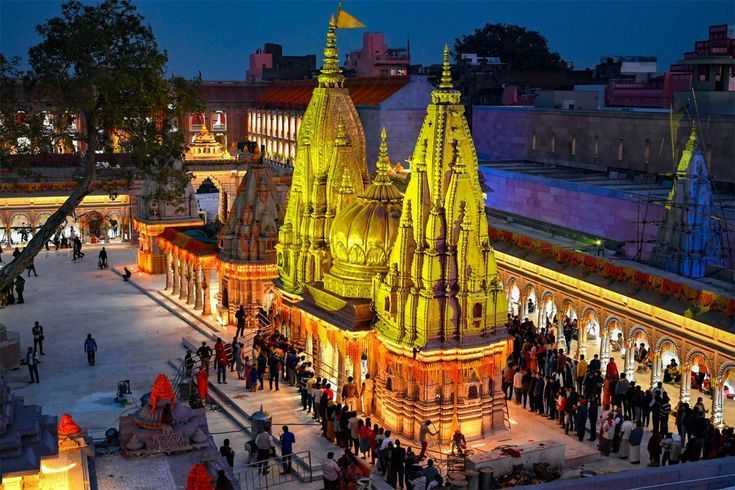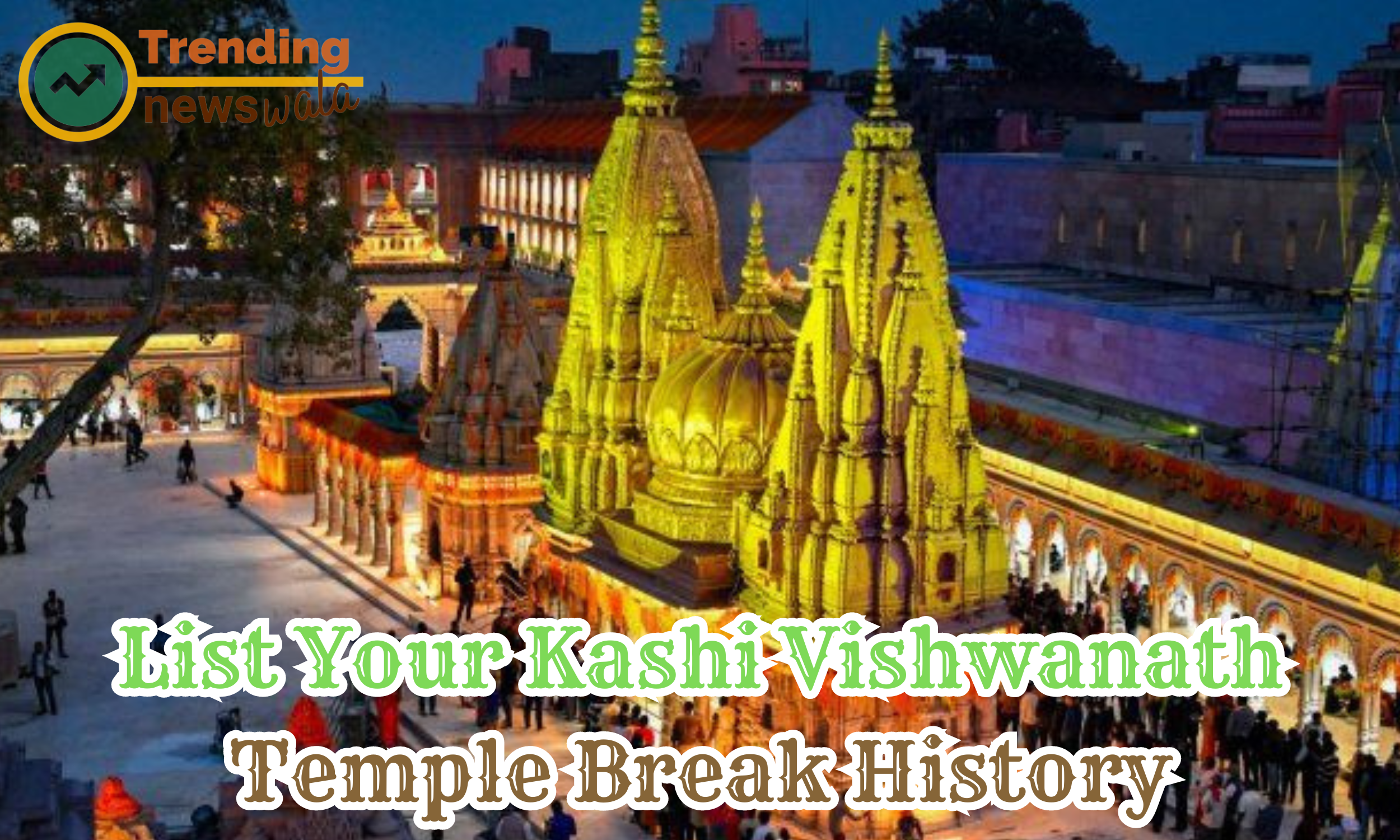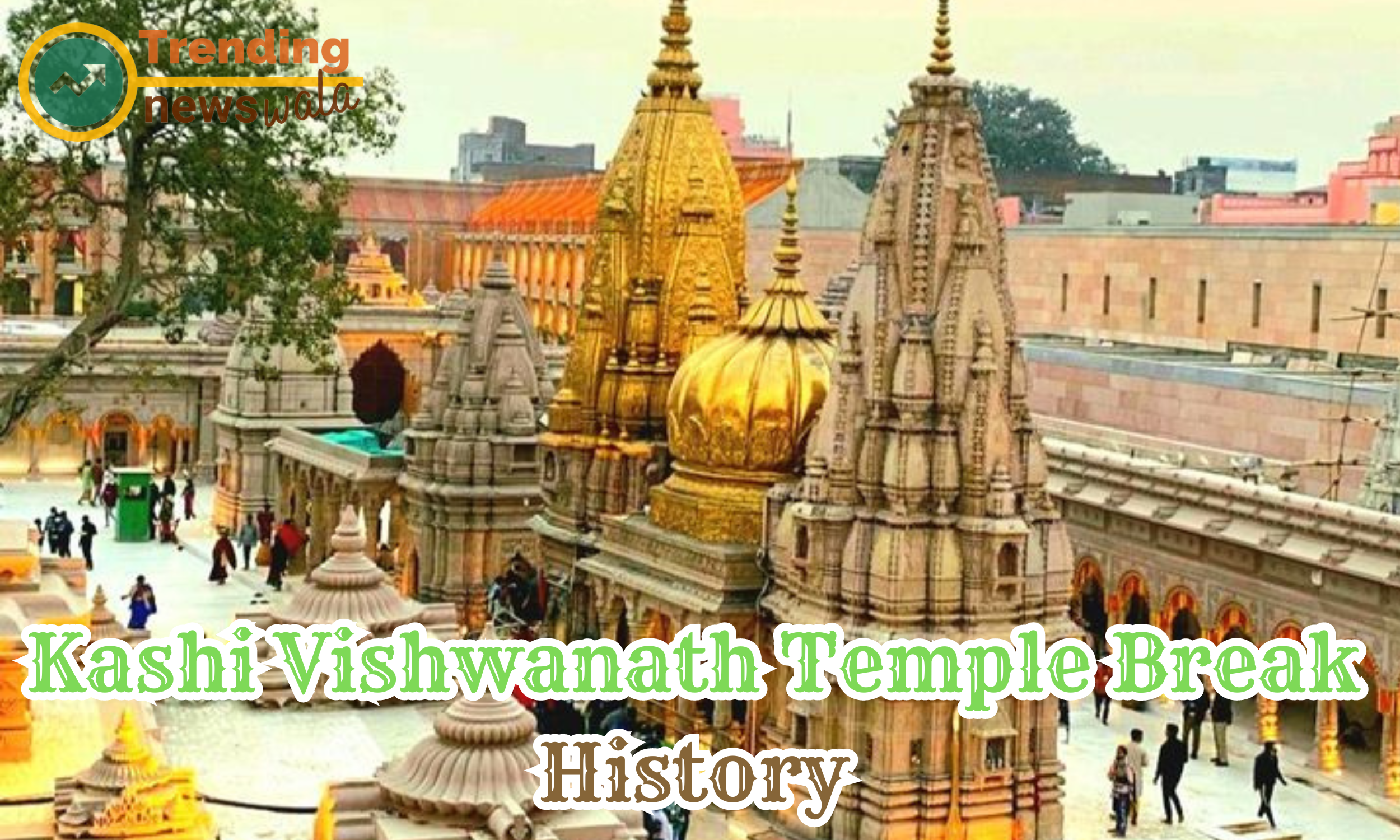Mughal emperor Aurangzeb, April 9, 1669, in Banaras “Kashi Vishwanath temple break” which was ordered to follow in August 1669, the Kashi Vishwanath temple was demolished to build the mosque was Gyanvapi. that Order a copy of the Asiatic Library today is apparently secured in Kolkata (am giving the order with the copy and see for themselves in the screenshot)
Nestled along the sacred banks of the Ganges River in Varanasi, the Kashi Vishwanath Temple stands as a timeless testament to the spiritual heritage of India. Over the centuries, this sacred shrine has witnessed the ebb and flow of history, serving as a symbol of devotion and cultural richness. In recent times, a historic break in the narrative of the Kashi Vishwanath Temple has unfolded, marking a significant chapter in its storied history.
Timeless Sanctity: The Kashi Vishwanath Temple, dedicated to Lord Shiva, has endured the passage of time for over a millennium. Pilgrims from across the world visit this revered site to seek spiritual solace, partake in sacred rituals, and immerse themselves in the mystical ambiance that envelops the temple and the ancient city of Varanasi.
The Gyanvapi Mosque and the Temple Complex: The Kashi Vishwanath Temple shares a complex history with the Gyanvapi Mosque, located adjacent to the temple premises. This coexistence has been a source of historical and religious significance, reflecting the intricate tapestry of India's diverse cultural and religious heritage.
Historical Tensions and Transformations: The history of the Kashi Vishwanath Temple has not been without its share of tensions and transformations. Over the centuries, the temple complex witnessed changes in rulership and underwent several architectural alterations. The cohabitation of the temple and mosque has been a testament to the historical syncretism that characterizes Varanasi.
Landmark Legal Decision: In a historic legal verdict in 2022, the Kashi Vishwanath Corridor project received approval from the court, allowing for the expansion and redevelopment of the temple complex. This decision marked a significant break in the temple's history, setting the stage for the rejuvenation of the spiritual center.
Kashi Vishwanath Corridor Project: The Kashi Vishwanath Corridor project aims to enhance the temple's infrastructure, providing pilgrims with improved amenities and restoring the spiritual and cultural grandeur of the site. The expansion involves reclaiming land around the temple, allowing for a more spacious and accessible pilgrimage experience.
Restoration of Spiritual Grandeur: The Kashi Vishwanath Corridor project represents a break from the limitations of the past, ushering in an era of transformation and restoration. The endeavor seeks to revive the spiritual grandeur of the temple, providing devotees with an enhanced and harmonious environment for worship and reflection.
Cultural and Religious Harmony: The Kashi Vishwanath Corridor project reflects a commitment to preserving the cultural and religious harmony that defines Varanasi. It is an attempt to create a space where people of diverse backgrounds can come together to experience the richness of India's spiritual heritage.
Impact on Pilgrimage Experience: The redevelopment of the Kashi Vishwanath Temple complex is poised to have a profound impact on the pilgrimage experience. Pilgrims can look forward to an improved infrastructure, cleaner surroundings, and a more organized flow of visitors, allowing for a more profound and meaningful connection with the divine.
Preserving Heritage for Future Generations: The Kashi Vishwanath Corridor project not only marks a break with the past but also underscores a commitment to preserving heritage for future generations. It is a step towards ensuring that the spiritual and cultural legacy of the Kashi Vishwanath Temple continues to shine brightly in the tapestry of India's history.
As the Kashi Vishwanath Temple undergoes this transformative phase, the pages of its history are being rewritten. The Kashi Vishwanath Corridor project serves as a beacon of progress, restoring and rejuvenating a spiritual icon that has endured for centuries. This break in the historical narrative is not a departure from tradition but a harmonious blend of preservation and progress, ensuring that the sacred flame of Kashi Vishwanath continues to illuminate the spiritual landscape of Varanasi for generations to come.
The Gyanvapi Mosque and the Temple Complex

The Gyanvapi Mosque and the Kashi Vishwanath Temple Complex share a complex history that intertwines religious, cultural, and architectural dimensions. This historic site, located in Varanasi, India, has witnessed centuries of coexistence, transformations, and at times, tensions. Here are more details about the Gyanvapi Mosque and the Temple Complex:
Geographical Context: Situated along the western bank of the Ganges River in Varanasi, the Kashi Vishwanath Temple and the Gyanvapi Mosque stand side by side within the same compound. This proximity is symbolic of the rich cultural and religious diversity that has characterized Varanasi for centuries.
Kashi Vishwanath Temple:
- The Kashi Vishwanath Temple, also known as the Golden Temple, is dedicated to Lord Shiva. It is one of the holiest Hindu temples and holds immense significance for devotees who believe that a visit to Varanasi and the temple can lead to salvation.
- The temple has undergone multiple constructions and renovations over the centuries. The current structure dates back to the 18th century when it was reconstructed by Rani Ahilyabai Holkar, the Queen of Indore.
- The temple complex is not just a place of worship; it is a cultural hub, adorned with intricate architecture, sculptures, and symbolic representations of Hindu mythology.
Gyanvapi Mosque:
- Adjacent to the Kashi Vishwanath Temple is the Gyanvapi Mosque. The mosque was constructed by the Mughal Emperor Aurangzeb in the 17th century during his reign. It is believed that the mosque was built on the site of a pre-existing Hindu temple.
- The mosque features Mughal architectural elements, including domes and minarets. Its location within the temple complex is emblematic of the historical coexistence of different religious and cultural identities in Varanasi.
Historical Transformations and Tensions:
- The history of the Kashi Vishwanath Temple and the Gyanvapi Mosque is marked by a series of transformations. The construction of the mosque on the site of an existing temple symbolizes a period of religious and cultural changes during Mughal rule in India.
- Tensions have arisen periodically over the years regarding the coexistence of the temple and mosque. However, the site continues to stand as a testament to the enduring ability of Varanasi to embrace diversity.
Pilgrimage and Rituals:
- Pilgrims visiting the Kashi Vishwanath Temple often also offer prayers at the Gyanvapi Mosque, embodying the spirit of religious tolerance and coexistence.
- The temple and mosque are integral to the religious rituals and practices that take place in Varanasi. The Ganges River, which flows nearby, adds to the sanctity of the entire complex.
Legal and Social Significance:
- The coexistence of the Kashi Vishwanath Temple and the Gyanvapi Mosque has been a subject of legal and social discussions. The legal landscape surrounding the site has seen various developments over the years.
- The recent approval of the Kashi Vishwanath Corridor project in 2022, which includes the redevelopment of the temple complex, adds a new chapter to the site's history, focusing on preserving its cultural heritage.
Cultural Harmony and Unity: Despite historical complexities, the Kashi Vishwanath Temple and the Gyanvapi Mosque stand today as symbols of cultural harmony and unity. The shared space represents the diverse tapestry of India, where different religious and cultural identities coexist in a spirit of mutual respect.
In conclusion, the Gyanvapi Mosque and the Kashi Vishwanath Temple Complex embody the rich historical and cultural tapestry of Varanasi. This site reflects the ability of the city to embrace diversity and remain a beacon of spiritual significance for people from various backgrounds. The recent developments in the form of the Kashi Vishwanath Corridor project indicate a commitment to preserving the heritage of this sacred complex for future generations.
Kashi Vishwanath Corridor Project

The Kashi Vishwanath Corridor Project is a significant redevelopment initiative aimed at transforming the area around the Kashi Vishwanath Temple in Varanasi, Uttar Pradesh, India. The project, which received approval in 2022, focuses on enhancing the infrastructure and overall experience for pilgrims visiting one of the holiest Hindu shrines.
Objective and Vision: The primary objective of the Kashi Vishwanath Corridor Project is to improve the overall infrastructure and amenities around the Kashi Vishwanath Temple. The vision is to create a more organized, accessible, and spiritually uplifting environment for the millions of devotees who visit the temple annually.
Reclaiming Land and Expanding the Temple Complex: One of the key components of the project involves reclaiming land around the Kashi Vishwanath Temple, allowing for the expansion of the temple complex. This expansion aims to provide more space for devotees, facilitating a smoother flow of visitors and enhancing their overall experience.
Redevelopment of Surrounding Area: The project encompasses the redevelopment of the entire vicinity surrounding the temple. This includes upgrading roads, pathways, and facilities to accommodate the increasing number of pilgrims and tourists.
Preservation of Heritage: While modernizing the infrastructure, a key focus of the project is to preserve the cultural and historical heritage of the area. Efforts are made to retain the architectural and cultural elements that contribute to the spiritual significance of Varanasi.
Improved Amenities for Pilgrims: The Kashi Vishwanath Corridor Project aims to enhance the overall pilgrimage experience by providing improved amenities for visitors. This includes better facilities for queuing, resting areas, clean and organized spaces, and accessibility features for people of all ages.
Harmony Between the Temple and Mosque: The project aims to maintain the historical harmony between the Kashi Vishwanath Temple and the adjacent Gyanvapi Mosque. It seeks to create an atmosphere of coexistence, emphasizing the shared cultural and religious heritage of the site.
Impact on Local Economy: The redevelopment project is expected to have a positive impact on the local economy by boosting tourism and creating job opportunities. The increased infrastructure and facilities are likely to attract more pilgrims and tourists to Varanasi.
Environmental Considerations: Environmental sustainability is taken into account in the redevelopment efforts. The project incorporates measures to minimize its ecological footprint, ensuring that the enhancements do not adversely affect the natural surroundings.
Legal Approvals and Community Engagement: The Kashi Vishwanath Corridor Project went through a legal approval process before implementation. Additionally, community engagement and consultation with stakeholders, including local residents and religious leaders, have been integral to the planning and execution of the project.
Symbolism and Spiritual Significance: Beyond its practical objectives, the project holds symbolic significance for devotees and the wider community. It represents a commitment to preserving and enhancing the spiritual and cultural legacy of the Kashi Vishwanath Temple, ensuring that it continues to be a beacon of spirituality for generations to come.
In conclusion, the Kashi Vishwanath Corridor Project stands as a testament to the ongoing efforts to balance tradition and modernity, ensuring that sacred sites like the Kashi Vishwanath Temple remain accessible, culturally vibrant, and spiritually enriching for all who seek solace within its sacred precincts.
Cultural and Religious Harmony

Cultural and religious harmony refers to the peaceful coexistence, mutual respect, and collaboration among people from diverse cultural and religious backgrounds. It involves fostering understanding, tolerance, and appreciation for the beliefs, practices, and traditions of different communities. Cultural and religious harmony is a vital aspect of societal well-being, promoting unity and inclusivity. Here are more details about cultural and religious harmony:
Understanding and Respect: Cultural and religious harmony begins with an understanding of the beliefs, customs, and traditions of different cultures and religions. It involves recognizing the diversity within a community and appreciating the unique contributions of each group.
Interfaith Dialogue: Interfaith dialogue plays a crucial role in promoting cultural and religious harmony. This involves open and respectful communication between representatives of different faiths, fostering understanding and building bridges of cooperation.
Celebration of Diversity: Rather than viewing diversity as a source of division, cultural and religious harmony celebrates the richness that diversity brings to a community. It recognizes that different cultures and religions contribute to the cultural mosaic of society.
Inclusive Practices: Inclusive practices ensure that individuals from various cultural and religious backgrounds feel welcomed and valued. This may involve creating inclusive spaces, events, and policies that consider the needs and sensitivities of diverse groups.
Promotion of Peaceful Coexistence: Cultural and religious harmony seeks to establish peaceful coexistence among communities with different cultural and religious affiliations. It emphasizes the importance of resolving conflicts through dialogue and understanding rather than through confrontation.
Education and Awareness: Education plays a vital role in promoting cultural and religious harmony. By educating individuals about different cultures and religions, stereotypes can be challenged, and misconceptions can be corrected, fostering an environment of respect and acceptance.
Shared Festivals and Celebrations: Participating in each other's festivals and celebrations is a practical way to promote cultural and religious harmony. This shared experience allows people to appreciate the cultural and religious significance of various events and fosters a sense of unity.
Collaborative Projects and Initiatives: Collaborative projects and initiatives that involve people from different cultural and religious backgrounds contribute to harmony. This could include joint community service projects, cultural events, or initiatives that address shared concerns.
Promotion of Common Values: Identifying and promoting common values that transcend cultural and religious boundaries can foster unity. Shared values such as compassion, justice, and respect for human dignity serve as foundations for cultural and religious harmony.
Legislation and Policies: Governments and organizations can play a role in promoting cultural and religious harmony by implementing inclusive policies and legislation that protect the rights of individuals from diverse backgrounds.
Community Leadership: Religious and community leaders have a significant role in promoting cultural and religious harmony. Their leadership can influence attitudes and behaviors within their communities, fostering an atmosphere of understanding and cooperation.
Cultural and religious harmony is an ongoing process that requires continuous effort, dialogue, and a commitment to fostering an inclusive and tolerant society. By embracing diversity and recognizing the shared humanity that unites us, communities can build bridges that promote harmony and understanding.

Nestled on the sacred banks of the Ganges River in Varanasi, the Kashi Vishwanath Temple stands as a living testament to The spiritual and cultural heritage of India. Steeped in centuries of history, the temple has weathered the sands of time, witnessing the ebb and flow of empires, the changing tides of culture, and the unwavering devotion of millions. In recent years, a transformative chapter has unfolded in the temple's history, marked by initiatives aimed at preserving its sanctity while ushering it into a new era.
A Beacon of Spiritual Illumination: The Kashi Vishwanath Temple, dedicated to Lord Shiva, is among the holiest shrines for Hindus. Its significance lies not only in its architectural grandeur but in its association with the cosmic forces that govern the universe, earning it the moniker "Vishwanath" or Lord of the Universe.
Centuries of Devotion and Dynasties:
- The temple's history traces back over a thousand years, witnessing the rise and fall of empires, from the Gupta Dynasty to the Mughals. Each dynasty left its imprint on the temple, contributing to its architectural splendor and cultural significance.
- Despite the passing centuries, the temple remained a steadfast symbol of devotion, drawing pilgrims from across the subcontinent who sought solace in its spiritual embrace.
Coexistence Amidst Diversity: The Kashi Vishwanath Temple shares its sacred precincts with the Gyanvapi Mosque, a testament to the historical coexistence of diverse religious and cultural identities. This shared space encapsulates the syncretic spirit of Varanasi, where Hindu and Muslim structures stand side by side.
The Winds of Change : In recent years, the Kashi Vishwanath Temple has become the focal point of transformative initiatives aimed at preserving its sanctity and enhancing the pilgrimage experience. The winds of change are embodied in the Kashi Vishwanath Corridor Project, a visionary endeavor that seeks to redefine the spiritual landscape around the temple.
Kashi Vishwanath Corridor Project:
- Approved in 2022, the Kashi Vishwanath Corridor Project represents a break from the limitations of the past. It envisions the reclamation of land around the temple, allowing for the expansion of the temple complex. The project aims to provide pilgrims with a more organized, accessible, and spiritually enriching environment.
- This ambitious undertaking is not merely about physical expansion; it is a holistic effort to preserve the cultural heritage, architectural marvels, and spiritual essence that define the Kashi Vishwanath Temple.
Preservation of Heritage and Spirituality:
- The Kashi Vishwanath Corridor Project emphasizes the preservation of heritage, ensuring that the intricate architectural details and cultural nuances of the temple are not only retained but enhanced for future generations.
- Amidst the expansion, the project maintains a delicate balance, respecting the historical harmony between the Kashi Vishwanath Temple and the Gyanvapi Mosque. It symbolizes an era where cultural and religious diversity is celebrated rather than diminished.
Impact on Pilgrimage Experience: As the Kashi Vishwanath Temple undergoes transformation, the pilgrimage experience is poised to reach new heights. Pilgrims can anticipate improved amenities, cleaner surroundings, and a seamless flow within the expanded temple complex.
Cultural Harmony and Unity: The Kashi Vishwanath Corridor Project stands as a beacon of cultural harmony, exemplifying unity in diversity. It reaffirms the cultural mosaic that Varanasi represents, where people from various backgrounds converge in a shared spiritual journey.
In the annals of history, the Kashi Vishwanath Temple has been a steadfast witness to the tapestry of India's cultural and spiritual heritage. The Kashi Vishwanath Corridor Project signals not only a break in the historical narrative but a harmonious fusion of tradition and progress. As the temple embraces its transformative phase, it remains a beacon of spiritual illumination, inviting pilgrims to partake in a journey that transcends time, connecting the past, present, and future in The divine embrace of Lord Shiva

What is the Kashi Vishwanath Temple?
The Kashi Vishwanath Temple is one of the holiest Hindu temples dedicated to Lord Shiva. Located in Varanasi, India, it holds immense religious and cultural significance and is considered a sacred pilgrimage site.
How old is the Kashi Vishwanath Temple?
The history of the Kashi Vishwanath Temple dates back over a thousand years, with its architecture and cultural significance evolving over different dynasties and periods.
What is the Gyanvapi Mosque's connection to the temple?
The Gyanvapi Mosque is situated adjacent to the Kashi Vishwanath Temple. The coexistence of the mosque and temple reflects the historical harmony between different religious and cultural identities in Varanasi.
What is the Kashi Vishwanath Corridor Project?
The Kashi Vishwanath Corridor Project is a transformative initiative aimed at enhancing the infrastructure and overall experience around the Kashi Vishwanath Temple. It involves reclaiming land, expanding the temple complex, and preserving cultural heritage while providing improved amenities for pilgrims.
When was the Kashi Vishwanath Corridor Project approved?
The Kashi Vishwanath Corridor Project received approval in 2022. The approval marked a significant milestone in the efforts to rejuvenate and redefine the spiritual landscape around the temple.
What is the vision behind the Kashi Vishwanath Corridor Project?
The project envisions creating a more organized, accessible, and spiritually enriching environment for pilgrims visiting the Kashi Vishwanath Temple. It aims to preserve cultural heritage while ushering in a new era of transformative change.
How does the project impact the pilgrimage experience?
The Kashi Vishwanath Corridor Project is expected to impact the pilgrimage experience positively by providing improved amenities, cleaner surroundings, and a more seamless flow within the expanded temple complex.
Is the Kashi Vishwanath Corridor Project preserving the heritage of the temple?
Yes, the project emphasizes the preservation of heritage, ensuring that the intricate architectural details and cultural nuances of the Kashi Vishwanath Temple are not only retained but enhanced for future generations.
What role does the Gyanvapi Mosque play in the project?
The Gyanvapi Mosque is part of the historical complex around the Kashi Vishwanath Temple. The Kashi Vishwanath Corridor Project maintains a delicate balance, respecting the historical harmony between the temple and the mosque.
How does the project contribute to cultural harmony and unity?
The project stands as a beacon of cultural harmony, exemplifying unity in diversity. It celebrates the diverse cultural and religious identities converging in Varanasi, fostering an atmosphere of shared spirituality.



